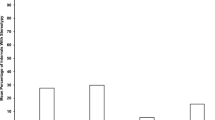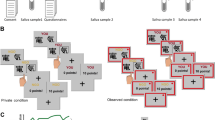Abstract
The behavior of preadolescent and adolescent boys, rated as aggressive and nonaggressive, was examined to test predictions from Bandura and Walters' social-learning theory and from Weiss and Miller's punishment model of audience-observation effects. The subjects were given a bogus motor task, actually insoluble, with help available on each trial. For half the subjects, help was given through the mediation of a social agent; for the rest, help was on a nonsocial, mechanically mediated basis. The groups for whom help was socially mediated made fewer help-seeking responses and decreased the number of such responses over successive trial blocks. The predictions from Bandura and Walters' theory were not supported, since neither age nor degree of aggressiveness had an effect on help-seeking responses. The results were, however, consistent with the punishment model of audience effects.
Similar content being viewed by others
References
Aronfreed J.,Conduct and conscience. New York: Academic Press, 1968.
Bandura, A. Relationship of family patterns to child behavior disorders. Progress Report, U.S. Public Health Service Research Grant M-1734, Stanford University, June 15, 1960.
Bandura, A., & Walters, R. H.Adolescent aggression. New York: Ronald Press, 1959.
Bandura, A., & Walters, R. H.Social learning and personality development. New York: Holt, Rinehart & Winston, 1963.
Berkowitz, L., & Daniels, L. Responsibility and dependency.Journal of Abnormal and Social Psychology, 1963,66, 429–436.
Byrne, D. Attitudes and attraction. In L. Berkowitz (Ed.),Advances in experimental social psychology, Vol. 4. New York: Academic Press, 1969.
Cottrell, N. B. Performance in the presence of other human beings: Mere presence, audience and affiliation effects. In E. C. Simmel, R. A. Hoppe, & G. A. Milton (Eds.),Social facilitation and imitative behavior. Boston: Allyn & Bacon, 1968.
Cottrell, N. B. Social facilitation. In C. G. McClintock (Ed.),Experimental social psychology. New York: Holt, Rinehart & Winston, 1972.
Cromwell, R. A methodological approach to personality research in mental retardation.American Journal of Mental Deficiency, 1959,64, 333–340.
Dollard, J., & Miller, N.Personality and psychotherapy. New York: McGraw-Hill, 1950.
Hollingshead, A. B.Two factor index of social position. New Haven, Conn.: Author, 1965.
Kagan, J. Socialization of aggression and the perception of parents in fantasy.Child Development, 1958,29, 311–320.
Krebs, D. L. Altruism-An examination of the concept and a review of the literature.Psychological Bulletin, 1970,73, 259–302.
Latané, B., & Darley J.,The unresponsive bystander: Why doesn't he help? New York: Appleton-Century-Crofts, 1970.
Latané, B., & Rodin, J. A lady in distress: Inhibiting effects of friends and strangers on bystander intervention.Journal of Experimental Social Psychology, 1969,5, 189–202.
Lerner, M. J., & Lichtman, R. R. Effects of perceived norms on attitudes and altruistic behavior toward a dependent other.Journal of Personality and Social Psychology, 1968,9, 226–232.
Lindquist, E. F.Design and analysis of experiments in psychology and education. Boston: Houghton Mifflin, 1953.
Piliavin, J. A., & Piliavin, I. M. Effect of blood on reactions to a victim.Journal of Personality and Social Psychology, 1972,23, 353–361.
Raush, H. L., Farbman, I., & Llewellyn, L. G. Person, setting and change in social interaction: II. A normal control study.Human Relations, 1960,13, 305–332.
Rotter, J. B., Liverant, S., & Crowne, D. P. The growth and extinction of expectancies in chance controlled and skilled tasks.Journal of Psychology, 1961,52, 161–177.
Sky, A. W. An apparatus for a frustration task.Australian Journal of Psychology, 1950,2, 116–120.
Walder, L. O., Abelson, R. P., Eron, L. D., Banta, T. J., & Laulicht, T. J. Development of a peer-rating measure of aggression.Psychological Reports, 1961,9, 497–556 (Monograph Supplement No. 4-V9).
Weiss, R. F., & Miller, F. G. The drive theory of social facilitation.Psychological Review, 1971,78, 44–57.
Williams, J., Meyerson, L., Eron, L., & Semler, I. Peer-rated aggression and aggressive responses elicited in an experimental situation.Child Development, 1967,38, 181–190.
Zajonc, R. B. Social facilitation.Science, 1965,149, 269–274.
Author information
Authors and Affiliations
Additional information
The preparation of this report was supported by U.S. Public Health Service, Maternal and Child Health Service Project No. 916, and by Grant HD-03110 from the National Institute of Child Health and Human Development. Appreciation is expressed to Miss Sydney Silverstein, who served as experimenter; to Mr. James Blank and Mr. William Blecker of the Iowa City Public School System; and to Dr. Jane E. Anderson, Dr. Dee W. Norton, Dr. A. L. Benton, and Dr. David A. Parton of the University of Iowa.
Rights and permissions
About this article
Cite this article
Shea, B.J., Routh, D.K., Cottrell, N.B. et al. Help seeking in aggressive and nonaggressive boys as a function of social or mechanical mediation of assistance. J Abnorm Child Psychol 1, 214–224 (1973). https://doi.org/10.1007/BF00916115
Issue Date:
DOI: https://doi.org/10.1007/BF00916115




